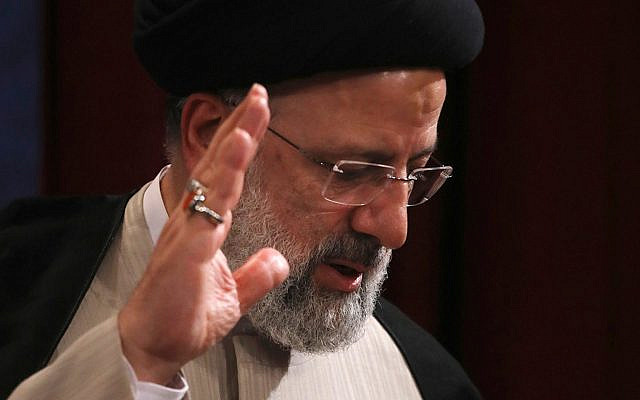MELVILLE, N.Y. — Chris Levi’s fellow soldiers were sure he was dead. The Humvee he commanded in Baghdad had been torn apart by a projectile, and so had his body. When he awoke several minutes later, he followed his training, trying to assess his injuries.
“I tried to wiggle my toes, and I couldn’t move them,” he recalled. Fearing he had been paralyzed, he reached down to feel his lower body. “It’s kind of hard to describe,” he said. “You could feel wet meat, and I knew I lost my legs.”
The device that nearly killed Mr. Levi in 2008 was an improvised bomb called an explosively formed penetrator, or E.F.P. — a weapon that blasted a teardrop-shaped slug of molten copper through the passenger door of his armored Humvee.
Though it was fired by Shiite militia members in Iraq, Mr. Levi has sought for years to hold another party responsible: Iran.
He and dozens of other soldiers injured during the Iraq war, as well as the families of hundreds of dead service members, have pursued justice in federal court. They sued Iran’s government in an effort to prove that the attacks that took their limbs and loved ones were aided by the Islamic Revolutionary Guard Corps.
Their fight was little noticed, with limited hope of recovering significant damages despite a ruling last year in their favor. Then another form of justice came this month, when an American missile killed the man they hold most responsible, Maj. Gen. Qassim Suleimani.
His name may not have been well known to most Americans, but the general had long been a focus of anger for many wounded veterans and families of those killed in Iraq. American officials have blamed General Suleimani for a campaign of roadside bombs and other attacks that they say killed hundreds of troops at the height of the Iraq war, which took the lives of nearly 4,500 American service members and left more than 30,000 wounded.
“He was the leader of the group that killed Dad,” Kelli Hake, whose husband died in an E.F.P. attack, recalled telling her 13-year-old son when she saw the news of General Suleimani’s death flash on television.
Image

Since 2007, the United States military has said that Iran, and specifically the Revolutionary Guard’s Quds Force, commanded by General Suleimani, provided Iraqi militias with the projectile weapons and the training needed to use them.
Last week, as White House claims that the general was killed to ward off imminent attacks on Americans were called into question, the administration sought to bolster its justification for the missile strike by also focusing on his role during the Iraq war. President Trump said in a televised statement on Wednesday that General Suleimani had “viciously wounded and murdered thousands of U.S. troops.”
The claim that Iran was partly responsible for losses in Iraq is at the heart of the lawsuit filed in February 2016 by more than 300 wounded veterans or relatives of dead service members.
The plaintiffs say the attacks at issue all had something in common: specialized weaponry or other materials or support provided by Iran. Primarily, that meant components for E.F.P. weapons, one of the most lethal devices wielded against Americans during the war. Using an explosive charge to launch a dense metal projectile at several times of the speed of sound, they could punch through the armor of almost any military vehicle.
Ms. Hake said she was skeptical when lawyers first approached her about the lawsuit. Although she might never see much money, she said she decided to join as a way to bring attention to Iran’s role in the attacks on her husband and others.
“I want it to be out there and known,” she said. Her son, Gage, was a toddler in March 2008 when his father, Staff Sgt. Christopher Hake, was killed by an E.F.P. that pierced the fuel tank of a Bradley fighting vehicle, setting it ablaze.
Ms. Hake remembers feeling grateful that her son was too young to remember his father’s death, but also devastated that he would not remember his life. The death of General Suleimani brought some of those emotions back, she said, but it also gave her a feeling of relief.
“It’s not that he physically killed Chris himself,” she said, “but he was the one who put those motions into action.”
So far, the case has focused on six specific E.F.P. strikes that killed and maimed troops, including Mr. Levi and Sergeant Hake, in Baghdad between 2005 and 2009, as well as a January 2007 kidnapping operation carried out by militiamen in central Iraq that resulted in the deaths of five service members.
In 2018, Judge Colleen Kollar-Kotelly of United States District Court for the District of Columbia conducted a three-day trial to closely examine who was behind the seven attacks. No one showed up from Iran to defend the case, which the plaintiffs filed under a law that allows Americans to seek damages from other countries for deaths and injuries caused by torture, terrorism and related acts.
Mr. Levi, who was a specialist in the Army, took the stand and described the day that the copper projectile tore through his Humvee, shattering his right arm and slicing his legs off above the knees. Over the next two years, he endured more than 100 operations at Walter Reed National Military Medical Center, where doctors fitted him for prosthetic legs and used a metal plate and screws to hold his arm and hand together.
Now, when he wants to play with his two small dogs, Marley and Remy, or when he expects a visit from his young nieces, Mr. Levi straps on a shorter set of prosthetics that give him a low center of gravity. “I love being able to throw those ‘feet’ on and be the same height as my nieces,” he said.
He also wears them when he hikes or wades into the ocean near his home on Long Island, which was built by the Stephen Siller Tunnel to Towers Foundation and is filled with amenities to help him live independently.
At the trial, Mr. Levi often engaged in what the judge described as “gallows levity.” But he sometimes broke down while listening to testimony about the deaths of other soldiers, including Sergeant Hake.
“I couldn’t stop crying, and I couldn’t leave,” Mr. Levi said, adding that it was important for the world to know what happened to them, and who was responsible. “It’s something other people needed to hear,” he said.
He added, “I’m lucky I only lost limbs.”
In August, in an initial ruling for the plaintiffs, Judge Kollar-Kotelly said that evidence gathered by United States military investigators and intelligence officials clearly showed that “material support” for the seven attacks she examined had “flowed through” General Suleimani’s Quds Force.
The general’s name appeared throughout her opinion, as she described the role he played as the head of Quds Force and the fact that he reported directly to Iran’s supreme leader, Ayatollah Ali Khamenei.
Now, in a new phase of the litigation, the judge is looking at evidence from more than 80 other attacks, most of them involving E.F.P.s, and will decide whether those strikes were also aided by Iran. Then a special master would recommend the amount of damages owed to each plaintiff.
There is little chance that Iran could be made to pay up directly. But plaintiffs like Mr. Levi and Ms. Hake may be able to receive money from a federal fund set up to compensate victims of state-sponsored terrorism, said their lawyer, Gary Osen.
Just how many troops were killed or wounded by Iranian-supplied weaponry during the Iraq war remains in dispute. The United States military said in 2015 that during a six-year stretch, E.F.P. attacks killed 196 American troops and wounded 861 others. More recently, the Pentagon has given an estimate of 600 American troop deaths from roadside bombs and various other attacks supported by Iran during the war.
Some experts, like Joe Cirincione, who was a longtime Democratic staff member in Congress, said evidence had never been presented to blame General Suleimani for 600 deaths or the “thousands” of casualties that Mr. Trump is now citing. But he said there was no question that Iran bears considerable responsibility.
“Can you pin every single E.F.P. attack on Suleimani? No, that’s going too far,” said Mr. Cirincione, who is now the president of Ploughshares Fund, a global security foundation. But, he said, “I’ve never heard anyone claim the Iranians did not supply these weapons.”
General Suleimani once sought to plead his innocence. In January 2007, the general told Jalal Talabani, the Iraqi president at the time, that his hands were clean, according to an American diplomatic cable later revealed by WikiLeaks.
“I swear on the grave of Khomeini I haven’t authorized a bullet against the U.S.,” the general said.
Patrick Farr, another plaintiff in the suit, does not believe him.
Mr. Farr’s son, Clay, a soldier on his first deployment in Iraq, was injured by a roadside bomb on the day he turned 21. The next day, he called his father from a hospital bed. It was the last time they talked. A week later, he was back in the field, and an E.F.P. struck the Humvee he was driving, killing him.
“He was all I had,” Mr. Farr said in an interview from California City, Calif. On the night the missile strike killed General Suleimani, he celebrated with his wife after reading the news on his phone.
“He changed our lives forever,” Mr. Farr said, adding, “I do take comfort that the last thing he heard was the sound of a United States missile coming down on his head.”
Richard A. Oppel Jr. reported from Melville, and Nicholas Bogel-Burroughs from New York. John Ismay contributed from Washington.












